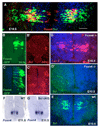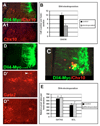A regulatory network involving Foxn4, Mash1 and delta-like 4/Notch1 generates V2a and V2b spinal interneurons from a common progenitor pool
- PMID: 17728344
- PMCID: PMC6329449
- DOI: 10.1242/dev.005868
A regulatory network involving Foxn4, Mash1 and delta-like 4/Notch1 generates V2a and V2b spinal interneurons from a common progenitor pool
Abstract
In the developing central nervous system, cellular diversity depends in part on organising signals that establish regionally restricted progenitor domains, each of which produces distinct types of differentiated neurons. However, the mechanisms of neuronal subtype specification within each progenitor domain remain poorly understood. The p2 progenitor domain in the ventral spinal cord gives rise to two interneuron (IN) subtypes, V2a and V2b, which integrate into local neuronal networks that control motor activity and locomotion. Foxn4, a forkhead transcription factor, is expressed in the common progenitors of V2a and V2b INs and is required directly for V2b but not for V2a development. We show here in experiments conducted using mouse and chick that Foxn4 induces expression of delta-like 4 (Dll4) and Mash1 (Ascl1). Dll4 then signals through Notch1 to subdivide the p2 progenitor pool. Foxn4, Mash1 and activated Notch1 trigger the genetic cascade leading to V2b INs, whereas the complementary set of progenitors, without active Notch1, generates V2a INs. Thus, Foxn4 plays a dual role in V2 IN development: (1) by initiating Notch-Delta signalling, it introduces the asymmetry required for development of V2a and V2b INs from their common progenitors; (2) it simultaneously activates the V2b genetic programme.
Figures









Similar articles
-
Asymmetric activation of Dll4-Notch signaling by Foxn4 and proneural factors activates BMP/TGFβ signaling to specify V2b interneurons in the spinal cord.Development. 2014 Jan;141(1):187-98. doi: 10.1242/dev.092536. Epub 2013 Nov 20. Development. 2014. PMID: 24257627 Free PMC article.
-
Foxn4 acts synergistically with Mash1 to specify subtype identity of V2 interneurons in the spinal cord.Proc Natl Acad Sci U S A. 2005 Jul 26;102(30):10688-93. doi: 10.1073/pnas.0504799102. Epub 2005 Jul 14. Proc Natl Acad Sci U S A. 2005. PMID: 16020526 Free PMC article.
-
Genetic dissection of Gata2 selective functions during specification of V2 interneurons in the developing spinal cord.Dev Neurobiol. 2015 Jul;75(7):721-37. doi: 10.1002/dneu.22244. Epub 2014 Nov 15. Dev Neurobiol. 2015. PMID: 25369423
-
Foxn4: a multi-faceted transcriptional regulator of cell fates in vertebrate development.Sci China Life Sci. 2013 Nov;56(11):985-93. doi: 10.1007/s11427-013-4543-8. Epub 2013 Sep 5. Sci China Life Sci. 2013. PMID: 24008385 Review.
-
Insights into the mechanisms of neuron generation and specification in the zebrafish ventral spinal cord.FEBS J. 2024 Feb;291(4):646-662. doi: 10.1111/febs.16913. Epub 2023 Aug 3. FEBS J. 2024. PMID: 37498183 Review.
Cited by
-
Induction of Ventral Spinal V0 Interneurons from Mouse Embryonic Stem Cells.Stem Cells Dev. 2021 Aug 15;30(16):816-829. doi: 10.1089/scd.2021.0003. Epub 2021 Jul 16. Stem Cells Dev. 2021. PMID: 34139881 Free PMC article.
-
Lhx4 surpasses its paralog Lhx3 in promoting the differentiation of spinal V2a interneurons.Cell Mol Life Sci. 2024 Jul 6;81(1):286. doi: 10.1007/s00018-024-05316-x. Cell Mol Life Sci. 2024. PMID: 38970652 Free PMC article.
-
Clonally related, Notch-differentiated spinal neurons integrate into distinct circuits.Elife. 2022 Dec 29;11:e83680. doi: 10.7554/eLife.83680. Elife. 2022. PMID: 36580075 Free PMC article.
-
Notch signaling determines cell-fate specification of the two main types of vomeronasal neurons of rodents.Development. 2022 Jul 1;149(13):dev200448. doi: 10.1242/dev.200448. Epub 2022 Jul 4. Development. 2022. PMID: 35781337 Free PMC article.
-
Mechanisms regulating GABAergic neuron development.Cell Mol Life Sci. 2014 Apr;71(8):1395-415. doi: 10.1007/s00018-013-1501-3. Epub 2013 Nov 7. Cell Mol Life Sci. 2014. PMID: 24196748 Free PMC article. Review.
References
-
- Artavanis-Tsakonas S, Rand MD, Lake RJ. Notch signaling: cell fate control and signal integration in development. Science. 1999;284:770–776. - PubMed
-
- Benedito R, Duarte A. Expression of Dll4 during mouse embryogenesis suggests multiple developmental roles. Gene Expr Patterns. 2005;5:750–755. - PubMed
-
- Briscoe J, Pierani A, Jessell TM, Ericson J. A homeodomain protein code specifies progenitor cell identity and neuronal fate in the ventral neural tube. Cell. 2000;101:435–445. - PubMed
-
- Casarosa S, Fode C, Guillemot F. Mash1 regulates neurogenesis in the ventral telencephalon. Development. 1999;126:525–534. - PubMed
-
- Castro DS, Skowronsky-Krawzyck D, Armant O, Donaldson IJ, Parras C, Hunt C, Critchley JA, Nguyen L, Gossler A, Göttgens B, et al. Proneural bHLH and Brn proteins coregulate a neurogenic program through cooperative binding to a conserved DNA motif. Dev Cell. 2006;11:831–844. - PubMed
Publication types
MeSH terms
Substances
Grants and funding
LinkOut - more resources
Full Text Sources
Other Literature Sources
Molecular Biology Databases

